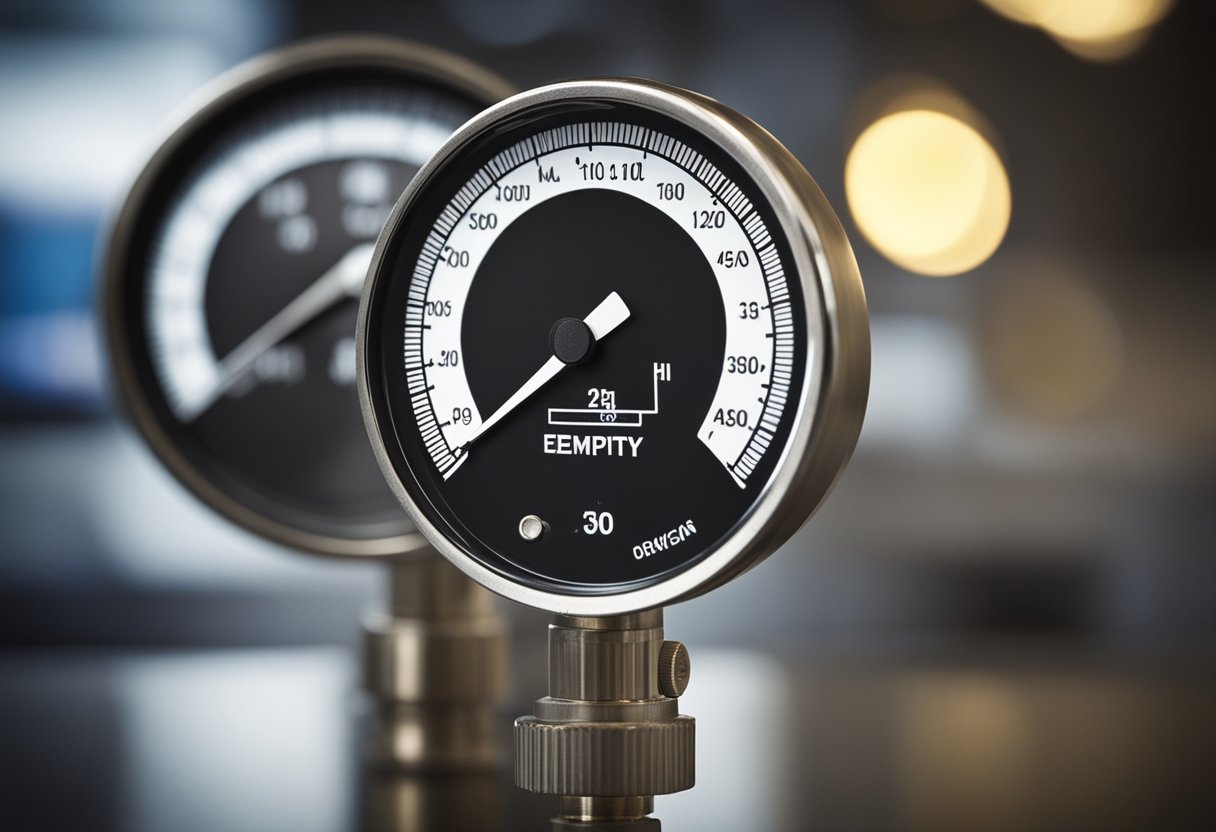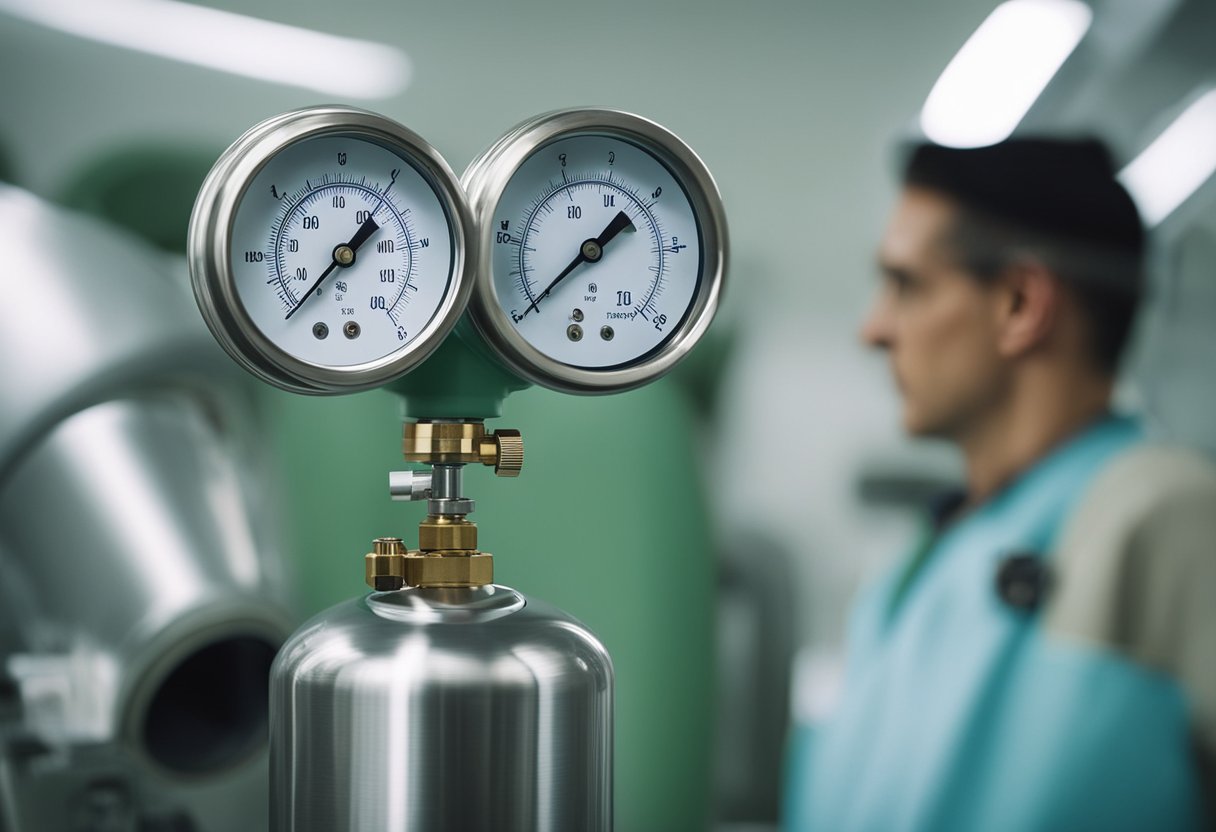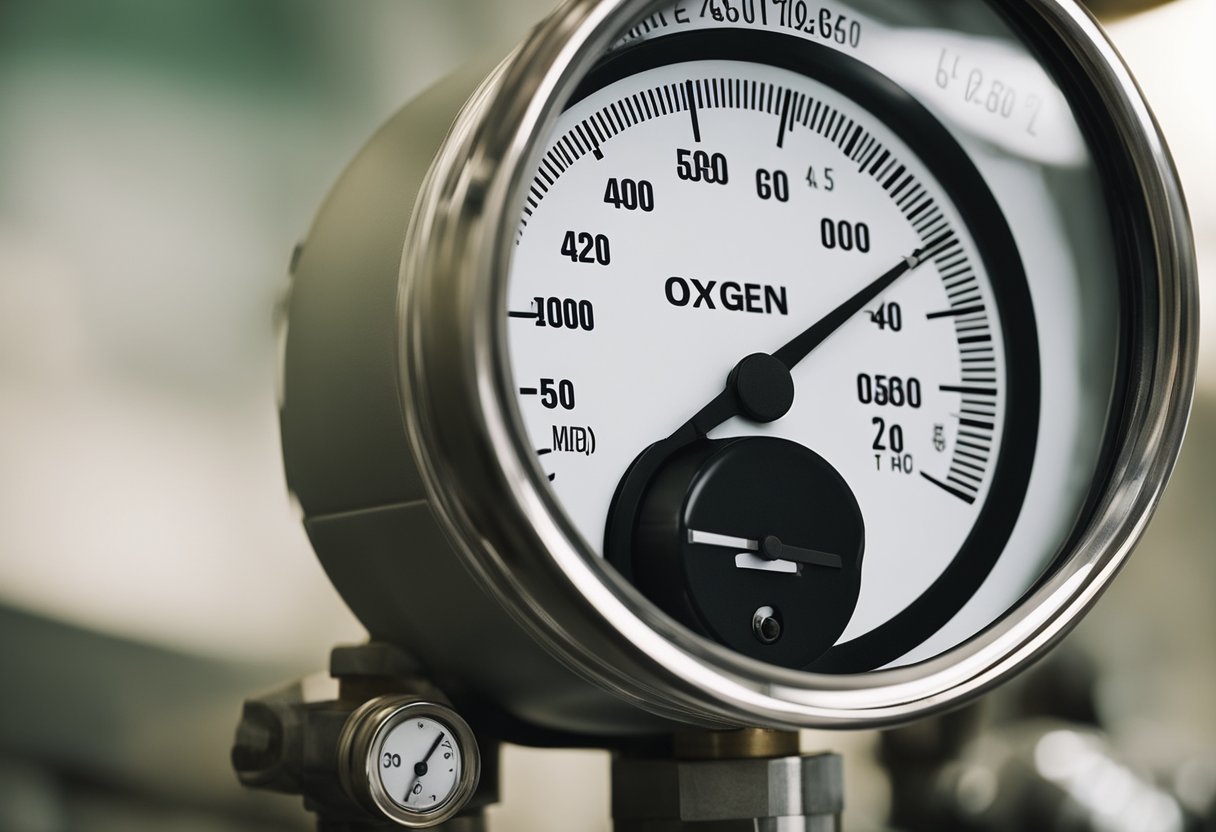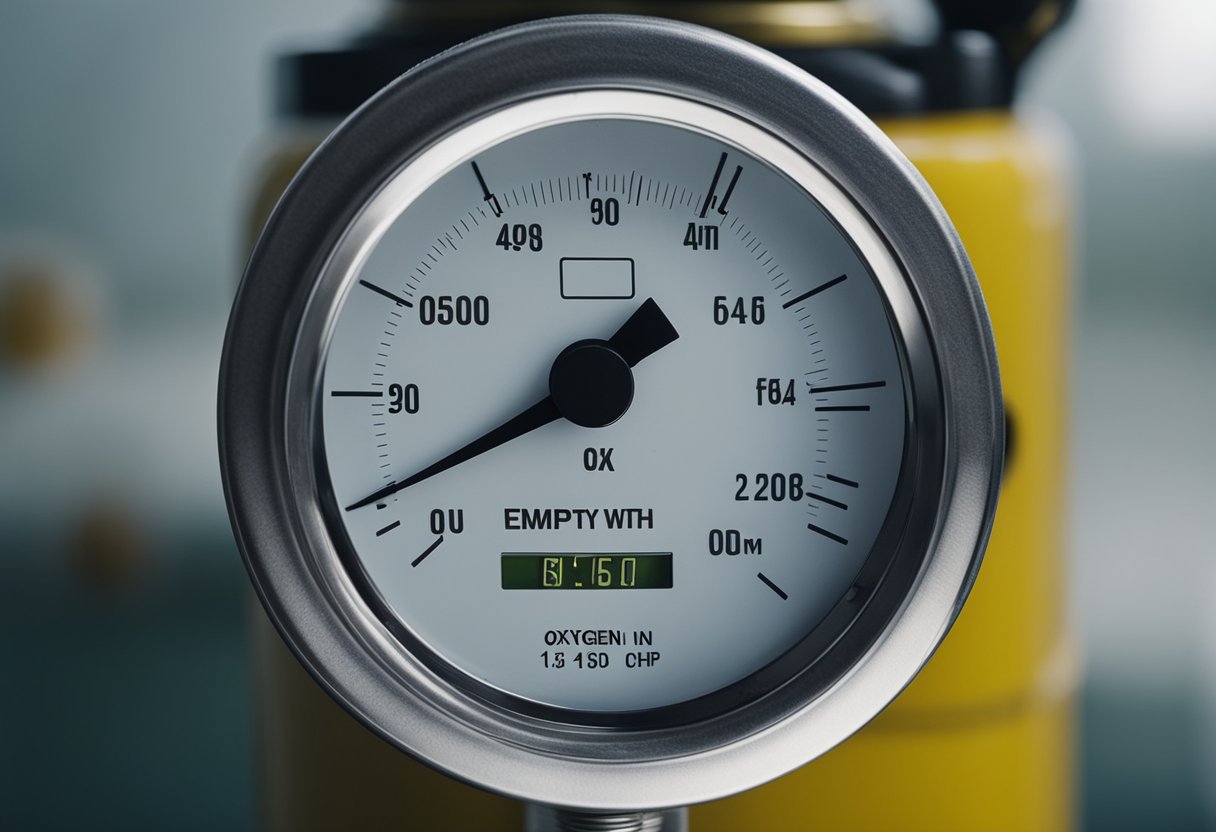As someone who uses an oxygen tank, it’s important to know when the tank is empty to avoid running out of oxygen. It can be difficult to tell when an oxygen tank is empty, especially if you’re not familiar with how they work. In this article, I will provide tips on how to identify an empty oxygen tank and what safety precautions to take when handling them.

Understanding how oxygen tanks work is crucial in identifying when they are empty. Oxygen tanks come in different sizes and shapes, but they all work in the same way. They store oxygen under pressure in a cylinder, and the pressure gauge on the tank shows the amount of oxygen left in the tank. When the pressure gauge reads zero, it’s time to replace the tank. However, there are other ways to tell if an oxygen tank is empty, which I will discuss in the next section.
Key Takeaways
- Oxygen tanks store oxygen under pressure in a cylinder and the pressure gauge on the tank shows the amount of oxygen left in the tank.
- When the pressure gauge reads zero, it’s time to replace the tank.
- Other ways to tell if an oxygen tank is empty include checking the weight, listening for a hissing sound, and looking for frost on the tank.
Understanding Oxygen Tanks
As someone who relies on an oxygen tank, it’s important to understand the different types and sizes of tanks available. This knowledge can help you determine when your tank needs to be refilled or replaced.
Types of Oxygen Tanks
There are two main types of oxygen tanks: compressed gas cylinders and liquid oxygen tanks. Compressed gas cylinders are the most common type of oxygen tank used in medical settings. They store oxygen gas under pressure in a metal cylinder. Liquid oxygen tanks, on the other hand, store oxygen in a liquid form at a much colder temperature than compressed gas cylinders.
Oxygen Tank Sizes
Oxygen tanks come in a variety of sizes, from small portable tanks to large stationary tanks. The size of the tank you need depends on the amount of oxygen you require and how long you need it for.
The most common type of compressed gas cylinder used in medical settings is the E cylinder. E cylinders are small and portable, making them easy to transport. They typically hold around 680 liters of oxygen gas and last for about 5 hours at a flow rate of 2 liters per minute.
Liquid oxygen tanks are larger and less portable than compressed gas cylinders. They are typically used for long-term oxygen therapy at home. Liquid oxygen tanks can hold more oxygen than compressed gas cylinders. For example, a small liquid oxygen tank can hold around 1600 liters of oxygen, which is more than double the amount of an E cylinder.
When choosing an oxygen tank, it’s important to consider the tank size in terms of cubic feet or liters. This measurement will help you determine how much oxygen the tank can hold and how long it will last at a certain flow rate.
In summary, understanding the different types and sizes of oxygen tanks can help you make an informed decision when choosing an oxygen tank. It can also help you determine when your tank needs to be refilled or replaced.
How to Read an Oxygen Tank
As someone who depends on an oxygen tank, it’s essential to know how to read the tank to avoid running out of oxygen. Here are some tips to help you understand the different gauges and indicators on an oxygen tank.
Understanding Pressure Gauges
The pressure gauge is usually located at the top of the oxygen tank. It may be a dial or digital display. Be careful not to confuse it with the flow meter, which measures the rate of oxygen being used. The pressure gauge indicates the pressure of oxygen in the cylinder. A full cylinder should read approximately 1800 psi, and the needle should be in the green area. As you use the oxygen in your cylinder, the pressure will drop. How quickly the pressure drops depends on the flow rate. When the pressure gauge reads low, approximately 500 psi, the needle will be in the red zone, indicating that it’s time to refill or replace the cylinder.
Interpreting Volume and Flow Rate
The regulator gauge displays the oxygen flow rate in liters per minute. It also shows the pressure level of the oxygen flowing from the cylinder. The flow gauge may have a dial or digital display. The dial display may have a red zone and a green zone. The green zone indicates that the flow rate is within the recommended range, while the red zone indicates that the flow rate is too high or too low. The flow rate is typically set by a healthcare professional based on your needs.
The cylinder pressure gauge and the flow gauge work together to provide information about the oxygen flow and volume. The cylinder pressure gauge indicates the amount of oxygen remaining in the cylinder, while the flow gauge shows how much oxygen is flowing from the cylinder per minute. The volume of oxygen in the cylinder is calculated by multiplying the cylinder pressure by the cylinder size. For example, if the cylinder pressure is 1500 psi and the cylinder size is E, the volume of oxygen in the cylinder is approximately 6800 liters.
In conclusion, knowing how to read an oxygen tank is crucial for anyone who depends on one. Understanding the different gauges and indicators can help you avoid running out of oxygen and ensure that you get the right amount of oxygen at the right flow rate.
Identifying an Empty Tank
As someone who relies on an oxygen tank, it’s important to know when your tank is running low or is completely empty. This can help you avoid unexpected interruptions in your oxygen supply and allow you to take appropriate action before it’s too late. In this section, I will discuss a few ways to identify an empty tank.
Weight and Temperature Indicators
One way to tell if your oxygen tank is empty is by checking its weight. An empty tank will weigh less than a full one. You can do this by using a scale that is capable of measuring the weight of your tank. Be sure to subtract the weight of any accessories, such as a regulator or mask, before weighing the tank. If the weight of the tank is significantly less than it should be, it’s likely that the tank is empty or close to it.
Another way to tell if your oxygen tank is empty is by checking its temperature. An empty tank will be at room temperature, while a full tank will be slightly cooler due to the expansion of the gas inside. You can use a thermometer to check the temperature of the tank. If the temperature is the same as the room temperature, it’s likely that the tank is empty or close to it.
Checking for Leaks
Another way to tell if your oxygen tank is empty is by checking for leaks. A leaky tank will lose pressure and may not provide enough oxygen to meet your needs. You can check for leaks by listening for hissing sounds or feeling for air currents around the tank. You can also use a soap and water solution to check for leaks. Apply the solution to the tank and look for bubbles. If you see bubbles, it’s likely that there is a leak.
In conclusion, there are several ways to identify an empty oxygen tank, including checking its weight and temperature and checking for leaks. By being aware of these indicators, you can ensure that you always have enough oxygen to meet your needs.
Safety Precautions with Oxygen Tanks
As someone who uses oxygen tanks, it is important to know how to handle and store them safely. Here are some safety precautions to keep in mind when using oxygen tanks.
Handling and Storage
When handling oxygen tanks, it is important to be careful and avoid dropping them. Oxygen tanks should be stored in a cool, dry place away from flammable materials like oil, cigarettes, and petroleum jelly. Water-based products are safe to use around oxygen tanks, but avoid using anything that is flammable.
Avoiding Flammable Materials
Oxygen is a highly combustible gas, and it is important to avoid anything that could cause combustion. Never smoke around oxygen tanks, and avoid using any electrical devices that could cause sparks or flames. This includes electric razors and batteries.
Electrical Safety
When using oxygen tanks, it is important to be aware of electrical safety. Always use grounded outlets and avoid using extension cords or power strips. If you need to use an extension cord, make sure it is rated for the device you are using and is in good condition.
By following these safety precautions, you can ensure that you are handling and storing oxygen tanks safely. Remember to always be cautious and avoid anything that could cause combustion or electrical hazards.
Refilling an Oxygen Tank
As someone who relies on an oxygen tank, it’s important to know when it’s running low. The last thing you want is to be caught without oxygen when you need it most. Here are some tips on how to refill your oxygen tank so you can avoid running out of oxygen.
First, you’ll need to determine whether your oxygen tank is empty or not. One way to do this is to check the pressure gauge on the tank. If the gauge is in the red or near the red, it’s time to refill the tank. Another way to tell if the tank is empty is to listen for a hissing sound when you turn on the oxygen. If you hear a hissing sound, it’s likely that the tank is empty.
Once you’ve determined that your oxygen tank needs to be refilled, you have a few options. You can take the tank to a welding supply store or medical supply company to have it refilled. Alternatively, you can refill the tank yourself if you have the proper equipment.
If you decide to refill the tank yourself, you’ll need to purchase an oxygen refill kit. These kits typically include a regulator, hose, and valve. You’ll also need to purchase oxygen, which can be found at welding supply stores or online.
To refill the tank, you’ll need to attach the regulator to the tank and open the valve. The oxygen will then flow from the refill kit into the tank. It’s important to monitor the pressure gauge on the tank to ensure that it doesn’t overfill. Once the tank is full, close the valve and disconnect the refill kit.
It’s important to note that if you’re using an oxygen tank for medical purposes, you should only refill it with medical-grade oxygen. Using welding gas or other types of gas can be dangerous and potentially harmful to your health.
In conclusion, refilling an oxygen tank can be done safely and easily with the proper equipment and knowledge. Whether you choose to have your tank refilled by a professional or do it yourself, it’s important to ensure that your tank is always full so you have access to the oxygen you need.
Medical Uses of Oxygen Tanks

Oxygen tanks are commonly used in medical settings to deliver supplemental oxygen to patients who have difficulty breathing. There are various medical uses of oxygen tanks, including oxygen therapy for chronic obstructive pulmonary disease (COPD) and other respiratory conditions, as well as for diving and other high-altitude activities.
Oxygen Therapy and COPD
Oxygen therapy is a common treatment for patients with COPD and other respiratory conditions. It involves the delivery of supplemental oxygen to help patients breathe more easily. Oxygen tanks are one of the delivery methods for oxygen therapy, along with oxygen concentrators and other devices.
Patients with COPD may require oxygen therapy for several reasons, including hypoxemia (low oxygen levels in the blood) and hypercapnia (high carbon dioxide levels in the blood). Oxygen therapy can help improve oxygenation, reduce shortness of breath, and improve exercise tolerance in patients with COPD.
Oxygen Delivery Methods
There are several methods for delivering oxygen to patients, including nasal cannula, face mask, and oxygen tanks. Nasal cannula is the most common method of oxygen delivery and involves inserting two small tubes into the nostrils. Face masks are also used to deliver oxygen, but they cover the nose and mouth.
Oxygen tanks are another delivery method for oxygen therapy. They store compressed or liquid oxygen and can be used for both short-term and long-term oxygen therapy. Oxygen tanks are commonly used for patients who require supplemental oxygen during sleep or exercise.
In conclusion, oxygen tanks are an important tool in the treatment of respiratory conditions such as COPD. They are one of several delivery methods for oxygen therapy and can help improve oxygenation, reduce shortness of breath, and improve exercise tolerance in patients with COPD.
Potential Complications and Solutions

Risk of Explosion
When using an oxygen tank, it is important to be aware of the risk of explosion. Oxygen is not flammable, but it does support combustion. This means that if there is a source of ignition, such as a spark or flame, in the presence of oxygen, a fire can start and quickly escalate into an explosion.
To prevent explosions, it is important to handle oxygen tanks with care. Never smoke or use an open flame near an oxygen tank. Keep the tank away from heat sources, such as radiators and stoves. Do not store the tank in direct sunlight or in a car trunk, as this can cause the temperature inside the tank to rise and increase the risk of explosion.
If you suspect that your oxygen tank is leaking or damaged, do not use it. Call your oxygen supplier or go to the hospital immediately.
Managing Asthma and Oxygen Tanks
For people with asthma, using an oxygen tank can be a lifesaver. However, it is important to be aware of the potential complications that can arise when using an oxygen tank with asthma.
One of the main complications is oxygen toxicity. This occurs when the body is exposed to high levels of oxygen for an extended period of time. Symptoms of oxygen toxicity include coughing, chest pain, shortness of breath, and confusion.
To prevent oxygen toxicity, it is important to use the oxygen tank only as directed by your doctor. Do not increase the flow rate or duration of use without consulting your doctor first.
Another complication is the risk of infection. Oxygen tanks can become contaminated with bacteria, which can cause infections in people with weakened immune systems. To prevent infections, it is important to clean and disinfect your oxygen tank regularly.
In conclusion, using an oxygen tank can be a safe and effective way to manage asthma and other respiratory conditions. However, it is important to be aware of the potential complications and take steps to prevent them. By handling your oxygen tank with care, following your doctor’s instructions, and keeping it clean, you can reduce the risk of complications and enjoy the benefits of oxygen therapy.
Frequently Asked Questions

How long does an oxygen tank usually last?
The duration of an oxygen tank depends on its size, the flow rate, and the frequency of use. For instance, a standard E-size oxygen tank can last between 5 to 15 hours when used continuously at 2 liters per minute (LPM). However, the same tank can last up to 40 hours when used at a lower flow rate of 0.5 LPM.
How do I know if my oxygen tank needs refilled?
It is essential to keep track of your oxygen tank’s contents to avoid running out of oxygen unexpectedly. You can estimate the oxygen level in your tank by checking the pressure gauge on the regulator. When the gauge reads 500 psi or lower, it’s time to refill the tank.
How can you tell how much oxygen is left in a tank?
You can estimate the amount of oxygen left in a tank by checking the pressure gauge on the regulator. The pressure gauge indicates the pressure inside the tank, which correlates with the amount of oxygen remaining. However, this is just an estimate, and you should have a backup tank on hand to avoid running out of oxygen.
What is the threshold for an empty oxygen tank?
An oxygen tank is considered empty when the pressure gauge reads zero psi. However, it is recommended to refill the tank when the pressure gauge reads between 500 and 1,000 psi to avoid running out of oxygen unexpectedly.
How do you read an oxygen tank regulator?
The regulator is the device that controls the flow of oxygen from the tank to the user. The regulator has a pressure gauge that indicates the pressure inside the tank and a flow meter that indicates the flow rate of oxygen. To read the regulator, check the pressure gauge to estimate the amount of oxygen remaining and adjust the flow meter to the prescribed flow rate.
What is a daily checklist for inspecting medical oxygen cylinders?
To ensure the safety and reliability of your oxygen tank, it is essential to inspect it daily. The checklist should include checking the tank for any physical damage or leaks, ensuring the regulator is properly attached, and checking the pressure gauge and flow meter to ensure they are functioning correctly. Additionally, it is essential to keep the tank upright and secured at all times to prevent it from falling over and causing damage.

Hi, I’m Sal Muller of Tooltrip.com. My DIY experience led me to understand essential power tools for home projects. Tooltrip.com guides enthusiasts and professionals in choosing right tools for any job. I provide concise top tool reviews for easier, efficient DIY.

